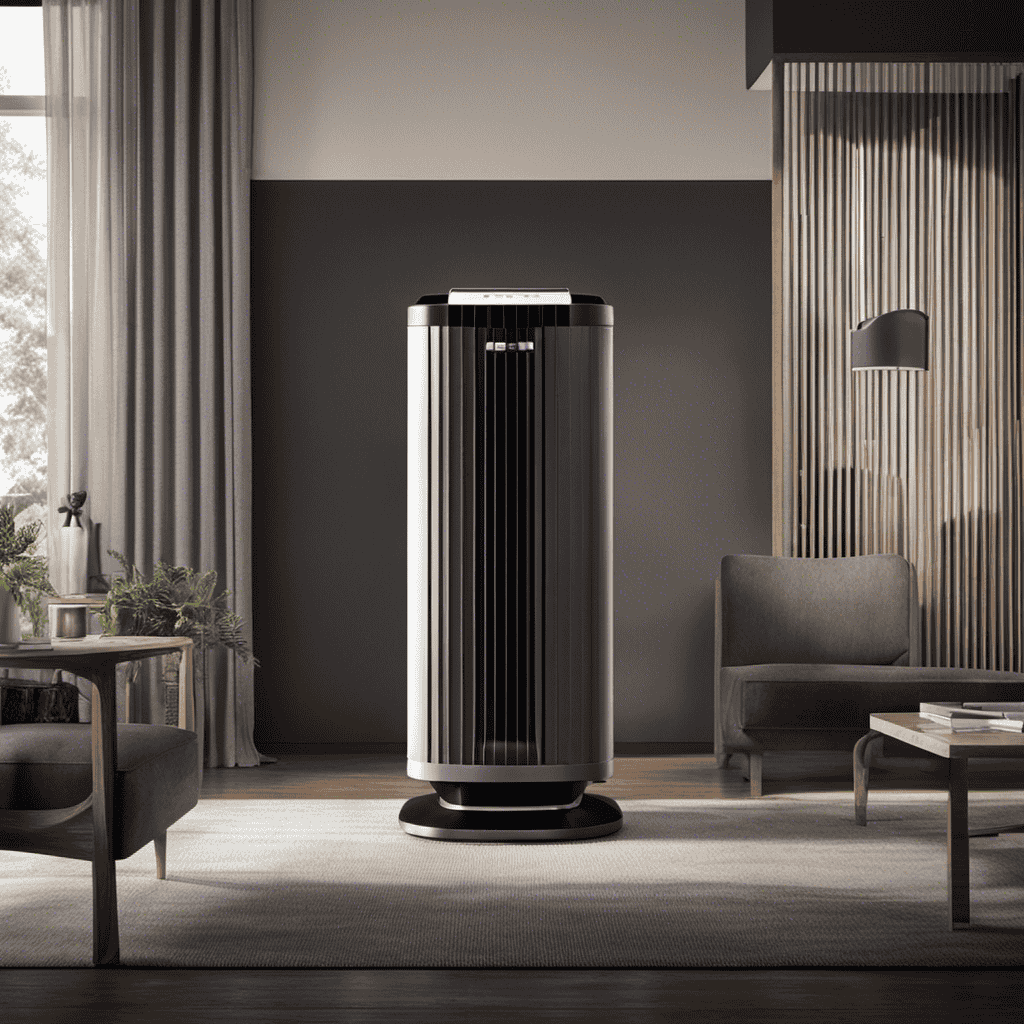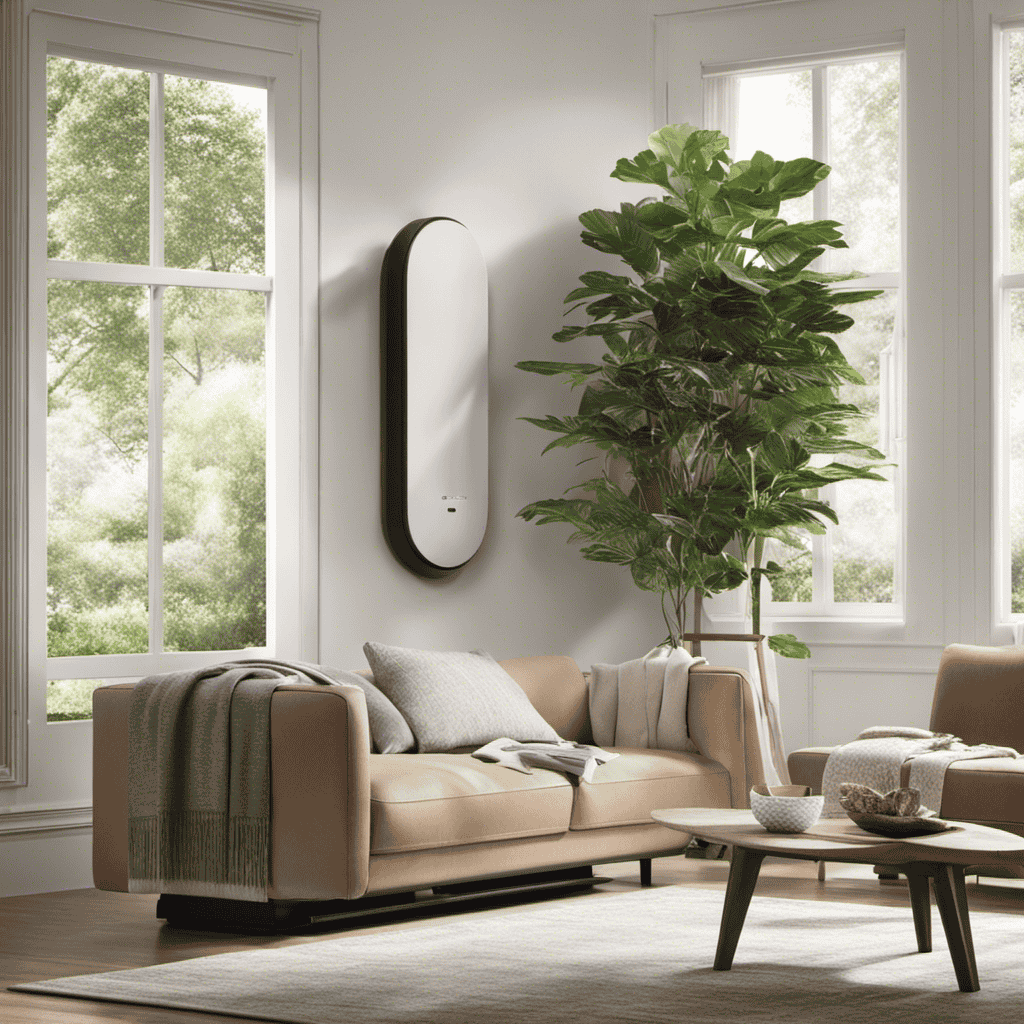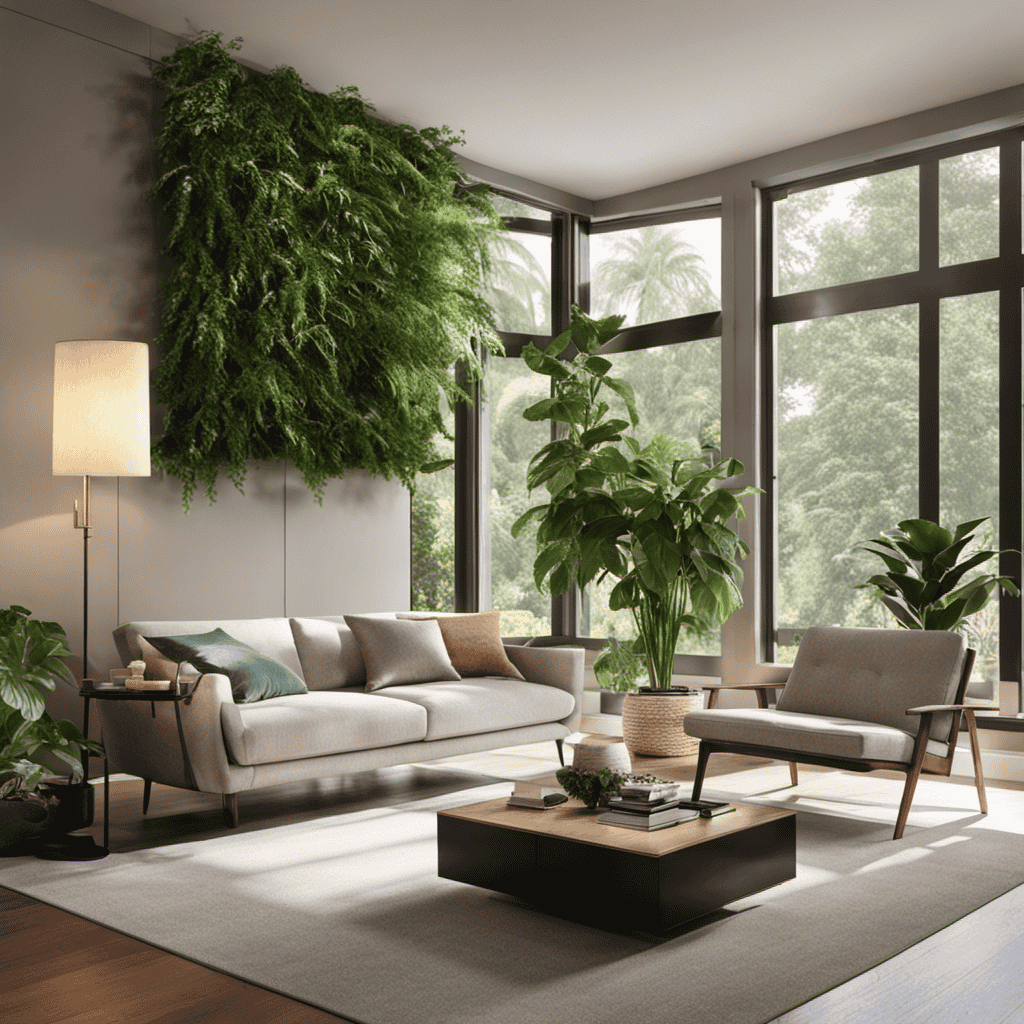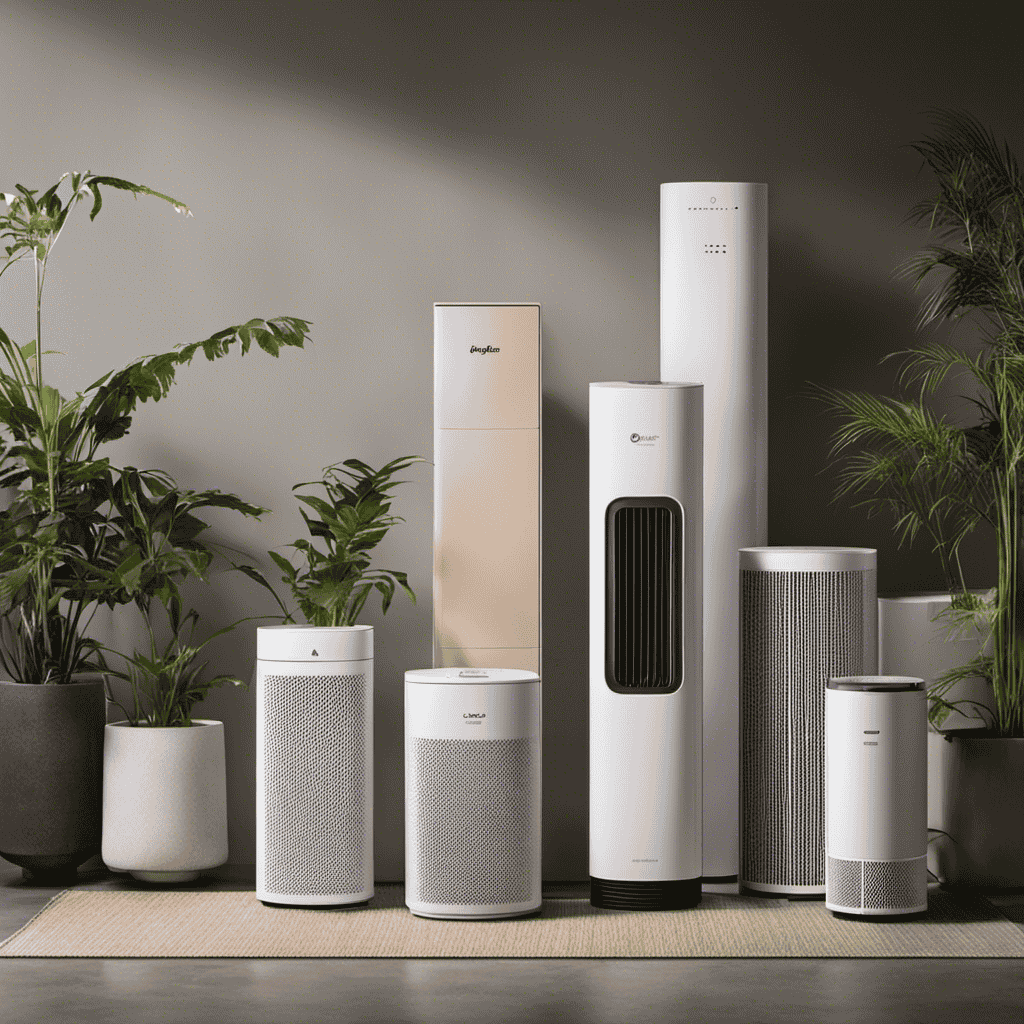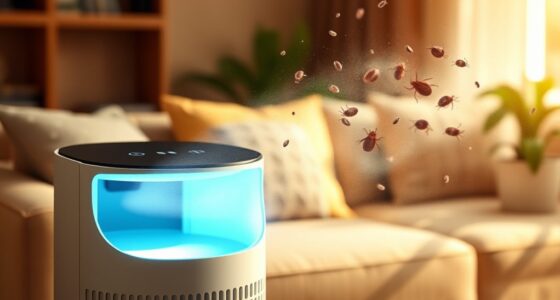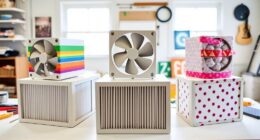Let’s delve into the world of air purifiers and learn about how they function because, as the saying goes, ‘Clean air is crucial for a healthy life.’
In this article, I will provide you with a technical and analytical breakdown of the different types of air purifiers, the role of filters, and the various air purification technologies available.
We will also discuss how these devices effectively remove particulate matter, address airborne allergens, eliminate odors, and even remove volatile organic compounds (VOCs).
Join me on this evidence-based journey as we uncover the impact of air purifiers on indoor air quality and learn how to choose the right one for your specific needs.
Key Takeaways
- Different types of air purifiers use various technologies for purification, including filtration, ionization, and ozone generation.
- Filters play a crucial role in trapping pollutants and allergens, with pre filters capturing larger particles and HEPA filters removing microscopic particles.
- Air purifiers can effectively remove airborne particles such as dust, pollen, pet dander, smoke, and volatile organic compounds (VOCs), improving indoor air quality.
- The effectiveness of air purifiers depends on factors such as particle size, air exchange rate, and filtration system efficiency, with HEPA filters being highly efficient in capturing small particles.
Types of Air Purifiers
There are different types of air purifiers available on the market. When it comes to air purifier maintenance, it is important to consider the type of purifier you have.
For example, some types may require regular filter replacements, while others may need to be cleaned regularly.
It is also important to consider the energy efficiency of air purifiers. Look for models that are Energy Star certified, as these are designed to use less energy while still providing effective air purification.
Additionally, consider the size of the room you will be using the air purifier in, as larger rooms may require a more powerful and energy-efficient model.
The Role of Filters in Air Purifiers
To effectively clean the air in your home, you’ll want to understand how filters play a crucial role in air purifiers. Filters are the workhorses of air purifiers, trapping pollutants and allergens to ensure clean and healthy air. There are different types of filters used in air purifiers, including pre filters and HEPA filters. Pre filters are the first line of defense, capturing larger particles like dust and pet dander. They help prolong the lifespan of the main filter by preventing it from clogging quickly. Ionizers, on the other hand, release negatively charged ions into the air, which attach to airborne particles, making them heavy and causing them to fall to the ground. Regular maintenance of air purifiers is essential to ensure optimal performance and longevity. This includes cleaning or replacing filters as recommended by the manufacturer. Understanding the role of filters and other components in air purifiers is crucial in maximizing their effectiveness in improving indoor air quality.
| Filter Type | Function | Benefits |
|---|---|---|
| Pre Filters | Capture larger particles like dust and pet dander | Prolong the lifespan of main filters |
| HEPA Filters | Trap microscopic particles | Remove allergens and pollutants |
| Ionizers | Release negatively charged ions | Make particles heavy, causing them to fall to the ground |
Understanding Air Purification Technologies
In discussing the different purification methods and the effectiveness of air purifiers, it’s important to understand the various technologies used in these devices.
Air purifiers employ a range of purification methods, including filtration, ionization, and ozone generation.
Evaluating the effectiveness of air purifiers involves considering factors such as the size and type of particles they can remove, their clean air delivery rate (CADR), and their ability to eliminate specific pollutants like allergens, odors, or volatile organic compounds (VOCs).
Different Purification Methods
One popular method of air purification is using high-efficiency particulate air (HEPA) filters. These filters are designed to capture airborne particles as small as 0.3 microns, effectively removing dust, pollen, pet dander, and other allergens from the air. However, HEPA filters are just one of the many different purification methods available today.
Here are four other methods commonly used in air purifiers:
-
Activated carbon filters: These filters use a highly porous material to absorb and trap odors, chemicals, and volatile organic compounds (VOCs).
-
Ultraviolet germicidal irradiation (UVGI): UVGI technology uses ultraviolet light to kill bacteria, viruses, and other microorganisms in the air.
-
Electrostatic precipitators: These devices use an electric charge to attract and capture particles, such as smoke and airborne pollutants.
-
Ozone generators: Ozone generators produce ozone gas, which can help eliminate strong odors and kill certain bacteria and viruses.
Investing in an air purifier can offer several benefits, including improved air quality, reduced allergies, and better respiratory health. However, it’s essential to understand the effectiveness of these devices in order to make an informed decision.
Effectiveness of Air Purifiers
You might be wondering how effective air purifiers are at improving indoor air quality and reducing allergens. Well, let’s dive into the evidence.
Numerous studies have shown the benefits of using air purifiers in reducing the concentration of airborne particles and improving respiratory health. These devices work by capturing and trapping particulate matter such as dust, pollen, pet dander, and even harmful pollutants like smoke and volatile organic compounds (VOCs).
The effectiveness of air purifiers depends on various factors such as the size and type of particles, the air exchange rate, and the efficiency of the filtration system. High-efficiency particulate air (HEPA) filters, for example, are known to remove 99.97% of particles as small as 0.3 microns.
Now, let’s explore how air purifiers remove particulate matter and enhance the quality of the air we breathe.
How Air Purifiers Remove Particulate Matter
When it comes to removing particulate matter from the air, air purifiers rely on various filtration methods.
These methods can include HEPA filters, activated carbon filters, and electrostatic precipitators.
The efficiency of particle removal depends on the type of filter used and its ability to capture and trap particles of different sizes.
The impact of these filtration methods on indoor air quality can be significant, as they help to reduce allergens, dust, and other harmful particles, resulting in cleaner and healthier air.
Filtration Methods Used
To understand how air purifiers work, it’s important to know about the different filtration methods used. Here are four key methods:
-
Electrostatic Precipitators: These devices use an electrostatic charge to trap particles as air passes through them. The charged particles then adhere to collector plates or other surfaces, effectively removing them from the air.
-
Activated Carbon Filters: These filters are highly effective at removing odors, chemicals, and gases from the air. The activated carbon has a large surface area, allowing it to adsorb these pollutants and trap them within its pores.
-
High-Efficiency Particulate Air (HEPA) Filters: HEPA filters are designed to capture microscopic particles as small as 0.3 micrometers in size. They use a combination of mechanical and electrostatic mechanisms to trap particles and provide clean air.
-
Ultraviolet Germicidal Irradiation (UVGI): UVGI utilizes ultraviolet light to destroy bacteria, viruses, and other microorganisms. The light damages their DNA, rendering them unable to reproduce and causing them to die off.
These filtration methods work together to ensure that air purifiers effectively remove pollutants and provide clean, healthy air.
Efficiency of Particle Removal
In terms of particle removal efficiency, air purifiers can vary depending on the filtration methods used.
While ionizers are often marketed as effective in eliminating airborne particles, research suggests that their effectiveness is limited. Ionizers produce negatively charged ions that attach to airborne particles, causing them to become heavy and fall to the ground or stick to surfaces. However, these particles can easily be stirred up again and re-enter the air.
On the other hand, High-Efficiency Particulate Air (HEPA) filters have been proven to be highly effective in removing particles as small as 0.3 microns. These filters capture particles by forcing air through a dense mesh, trapping even the smallest pollutants.
HEPA filters are particularly beneficial for individuals with allergies or respiratory conditions, as they can effectively remove common allergens like dust, pollen, and pet dander from the air.
Impact on Indoor Air
You can improve the quality of the air indoors by using an air purifier. Here are four reasons why you should consider investing in one:
-
Reduces indoor air pollutants: Air purifiers are designed to remove harmful particles and pollutants from the air, such as dust, pollen, pet dander, and mold spores. This helps to create a cleaner and healthier environment for you and your family.
-
Improves respiratory health: By removing these indoor air pollutants, air purifiers can help reduce the risk of respiratory issues such as allergies, asthma, and other respiratory illnesses. This is especially beneficial for individuals with pre-existing respiratory conditions.
-
Eliminates odors: Air purifiers are effective in removing unpleasant odors from the air, such as cooking smells, pet odors, and smoke. This helps to create a fresher and more pleasant living space.
-
Enhances overall well-being: Breathing clean air can have a positive impact on your overall well-being. It can improve sleep quality, increase productivity, and reduce stress levels.
Investing in an air purifier can provide numerous health benefits and contribute to a healthier indoor environment.
Addressing Airborne Allergens With Air Purifiers
Avoiding airborne allergens is easier with an air purifier – it filters out particles that can trigger allergy symptoms. Air purifiers offer several benefits in addressing airborne allergens.
They work by pulling in the surrounding air and passing it through a series of filters that capture allergens like pollen, dust mites, pet dander, and mold spores. These filters are designed to trap even the smallest particles, ensuring cleaner air.
Regular maintenance of the air purifier is essential to ensure its optimal performance. This includes cleaning or replacing the filters as recommended by the manufacturer. Failure to maintain the air purifier can result in reduced efficiency and effectiveness in removing allergens from the air.
Odor Elimination and Air Purifiers
To effectively eliminate odors, an air purifier with activated carbon filters is highly recommended. These filters are specifically designed to trap and remove odorous molecules from the air, leaving your space smelling fresh and clean.
Here are four key benefits of using air purifiers for odor elimination:
-
Efficiency: Air purifiers with activated carbon filters can effectively remove a wide range of odors, including those from pets, cooking, smoke, and chemicals.
-
Improved Air Quality: By removing odors, air purifiers help improve the overall quality of the air you breathe, reducing the risk of respiratory issues and allergies.
-
Low Maintenance: Regular air purifier maintenance, such as replacing filters and cleaning the unit, ensures optimal performance and longevity.
-
Versatility: Air purifiers can be used in various settings, such as homes, offices, and even cars, providing odor elimination wherever it is needed.
By incorporating an air purifier into your space, you can enjoy the benefits of odor elimination and improved air quality.
Transitioning into the subsequent section about ‘air purifiers and VOC removal’, let’s explore how these devices can also tackle volatile organic compounds.
Air Purifiers and VOC Removal
In our previous discussion on odor elimination and air purifiers, we explored how these devices can effectively remove unpleasant smells from the air. Now, let’s delve into another important aspect of air purifiers: VOC removal.
Volatile Organic Compounds (VOCs) are harmful gases emitted by various household products, such as paints, cleaning supplies, and furniture. These compounds can have detrimental effects on our health and the environment. Thankfully, air purifiers equipped with advanced filtration systems can effectively remove VOCs from the air, ensuring a healthier indoor environment.
To illustrate the effectiveness of air purifiers in VOC removal, let’s take a look at the following table:
| VOC Removal Technique | Benefits |
|---|---|
| Activated Carbon Filter | Traps and absorbs VOC molecules, reducing their concentration in the air |
| Photocatalytic Oxidation | Breaks down VOCs into harmless byproducts through a chemical reaction |
| Plasmacluster Ion Technology | Neutralizes VOCs by releasing positive and negative ions into the air |
| Ultraviolet Germicidal Irradiation | Destroys VOCs and other harmful pollutants through exposure to ultraviolet light |
The Impact of Air Purifiers on Indoor Air Quality
Improving your indoor air quality is essential, and one effective way to achieve this is through the use of air purifiers equipped with advanced filtration systems. These devices are designed to remove airborne pollutants, such as dust, pollen, pet dander, and even harmful chemicals.
Here are four reasons why air purifiers are beneficial for your long-term health:
-
Reduces allergens: Air purifiers capture and trap allergens, preventing them from circulating in the air and triggering allergic reactions.
-
Removes harmful particles: Advanced filtration systems can effectively remove fine particles, such as PM2.5, which are known to have negative health effects.
-
Eliminates odors: Air purifiers with activated carbon filters can eliminate unpleasant odors caused by cooking, pets, or tobacco smoke.
-
Low maintenance: Regular air purifier maintenance, such as cleaning or replacing filters, ensures optimal performance and long-term benefits for your health.
Investing in an air purifier and practicing proper maintenance can provide significant long-term health benefits by improving the quality of the air you breathe indoors.
Choosing the Right Air Purifier for Your Needs
When choosing the right air purifier for your needs, consider factors such as room size, filtration technology, and noise level. It’s important to find an air purifier that is both effective and cost-effective in maintaining clean indoor air. To help you make an informed decision, I have created a table below comparing three popular air purifiers based on these factors:
| Air Purifier | Room Size (sq. ft) | Filtration Technology | Noise Level (dB) |
|---|---|---|---|
| Model A | 300-500 | HEPA | 40 |
| Model B | 500-700 | Carbon | 50 |
| Model C | 700-1000 | Plasma | 35 |
Frequently Asked Questions
Can Air Purifiers Remove Viruses and Bacteria From the Air?
Yes, air purifiers can effectively remove viruses and bacteria from the air, including COVID-19. They have been proven beneficial in hospitals, reducing the risk of airborne transmission and improving overall air quality.
How Often Do Air Purifier Filters Need to Be Replaced?
Air purifier filters need to be replaced regularly to maintain optimal performance. Proper air purifier maintenance involves checking the manufacturer’s recommendations for the specific model and replacing the filters accordingly.
Can Air Purifiers Help With Asthma and Respiratory Conditions?
Yes, air purifiers can help with asthma and respiratory conditions. They remove allergens from indoor air, improving air quality. Studies show that using air purifiers can reduce symptoms and improve overall respiratory health.
Do Air Purifiers Produce Any Harmful Ozone?
Air purifiers emit ozone, but the amount is typically low and considered safe. However, some models may produce higher levels that can be harmful, especially for those with respiratory conditions. Indoor air quality can be improved by using air purifiers with low ozone emissions.
Can Air Purifiers Eliminate Pet Dander and Pet Odors?
Yes, air purifiers can eliminate pet dander and pet odors. They are beneficial for allergy sufferers as they filter out allergens and remove pet-related odors, creating a cleaner and fresher indoor environment.
Conclusion
In conclusion, air purifiers are essential for maintaining clean and healthy indoor air quality. They effectively remove particulate matter, allergens, and unpleasant odors from the air. According to a study conducted by the Environmental Protection Agency, indoor air can be two to five times more polluted than outdoor air. This statistic highlights the importance of investing in an air purifier to ensure a safe and comfortable living environment.
By understanding the different types and choosing the right air purifier, you can significantly improve the air quality in your home.
